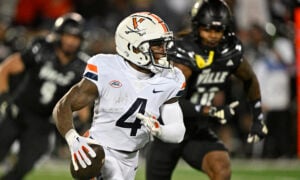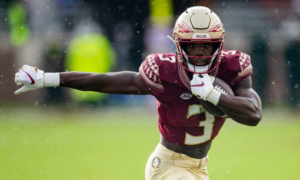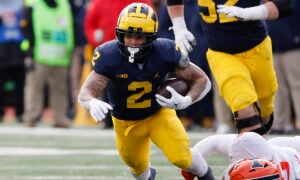The Top Five Durable Players by Position: Part One
Last month, DLF introduced a method of injury profiling players by the durability and susceptibility metrics I developed. To summarize the introductory article: durability score was established as a numerical indicator for the likelihood a player either avoided injury or played despite an injury.
The susceptibility metric works as a descriptive for the durability metric by indicating how many injuries contributed to the durability score. Susceptibility scores provide critical insight on how a player experiences injury by differentiating those who suffered from few catastrophic injuries and those who sustain a large quantity of smaller injuries. After quantification, a distribution curve was used to group players into five risk groups (Durability and Susceptibility Group). This allows for the quick classification of injury risk involved with each individual.
Currently, the DLF team and I are working on establishing a database for you to reference. In the meantime, please feel free to view additional players here. Using these calculations as a guide, I will share five players across each fantasy position with a strong history of durability throughout their career. In the first part of this article, I will cover the quarterback and running back positions.
[am4show have=’g1;’ guest_error=’sub_message’ user_error=’sub_message’ ]
Quarterback

What feels like long time ago, Drew Brees parted ways with the San Diego Chargers after concerns emerged over what doctors called a “potential chronic shoulder injury.” Ironically, Brees now stands alone as the pinnacle of quarterback durability. In fact, he has only been cited on three injury reports since becoming a New Orleans Saint. Despite climbing in age (38), thus far Brees has failed to display the requisite decrease in durability seen in those in the twilight of their career. This leads me to believe Brees could remain an asset for the next three-to-five seasons. Many casual players have begun to underestimate his longevity, which is providing an opportune buying window for a durable and highly productive quarterback. Feel confident and acquire Brees for both the dynasty and redraft setting.
The second most durable quarterback shown was the successor to Brees; Philip Rivers. Another seasoned veteran, Rivers proves to be the ideal late round quarterback in all start-up drafts. Despite an organization that appears to be annually plagued with injuries to the skilled positions, Rivers remains the pillar of the Chargers offense. With an ADP of 154, Rivers provides high-end upside like Brees at an even larger discount and longer career expectancy.
Kirk Cousins continues to show as the polar opposite of his predecessor, Robert Griffin III, who returned the worst durability score since 2000 for a quarterback. While Cousins has held the keys to the Washington offense for three seasons, he fits the accuracy benchmark for both metrics. The conclusions are clear that Cousins will prove to be a dependable asset moving forward. Playing in the clear majority of games, Cousins returns a higher than expected susceptibility score. At this point the result should be deemed positive for fantasy gamers, as it indicates he holds a heightened ability to play through injury. This young quarterback is a solid target for your dynasty team, as he postures towards a long and consistent career in the NFL.
Russell Wilson is the first surprise of the durability metric, as many owners have bought into the notion that Wilson has an inability to avoid injury due to his scrambling tendency and a below average offensive line. While memories of his past seasons refute the claim Wilson is durable, it is important to know that Wilson has only sustained three unique injuries and failed to miss a game to date. Unlike the other quarterbacks in the list above, Wilson’s susceptibility score indicates his previous injuries were not severe enough to prevent him from playing. Due to these injuries, it is without a doubt his production was impacted as a result. Easily a top five quarterback in my dynasty rankings, Wilson holds long-term viability and durability that cannot be matched by similarly ranked quarterbacks like Andrew Luck or Cam Newton. Moving forward, I am targeting Wilson with confidence, due to his ability to play through injury paired with the massive upside he provides when he puts together an injury-free season.
I’ll be honest, Tyrod Taylor is not a name I expected to find so high on this list. While his scores are likely aided by his reduced exposure while serving as a back-up, he has shown a spark of resilience reminiscent of Russell Wilson. When pairing Taylor’s impressive durability with a low ADP 157 and daring scrambling style, he highlights as a sound reserve for your roster.
Running Back

Topping the list of durable running backs is Super Bowl standout James White. Despite his limited play through the regular season, White flashed his receiving prowess in a diminished running back depth chart. Moving forward, I am comfortable with acquiring White as a lottery ticket and contrarian play against Mike Gillislee and Rex Burkhead, both of whom scored in the lowest durability group.
Jeremy Hill might surprise many that he appears on this list. However, Hill has displayed the consistent ability to play in the face of injury. While there is much debate as to the talent level of Hill, I believe that his performance was heavily impacted by his knee injuries. Despite the addition of rookie Joe Mixon, Jeremy Hill remains one of my favorite buy-low options. According to head coach Marvin Lewis, Hill is solidified as the clear back-up to Mixon and appears to be posturing as the primary goal-line option in 2017. At a low cost, Hill could prove to win out in the “war of attrition” this season and provide your team with carries at a critical time in the fantasy season. Lastly, Hill is a free agent in the upcoming off-season, thus there is hope for greener pastures with a different organization.
After this study, no one sky rocketed up my rankings more than Devonta Freeman. Despite working in a time-share, Freeman holds immense upside due to his glass cannon counter-part, Tevin Coleman. When Coleman was absent from Atlanta’s weekly line-up, Devonta Freeman averaged over 21 fantasy points per game. This is not to mention he holds an incredible resilience to injury as he has only been cited for two unique injuries since joining the Falcons in 2014. While no one is immune to the injury bug, Freeman should be aggressively attained in dynasty and redraft formats. In a recent trade, I was willing to send Le’Veon Bell for Freeman and additional assets. Pull the trigger, NOW.
After Cleveland made a clear effort to bolster their running game by adding numerous high-profile offensive linemen, fantasy owners have crowned Isaiah Crowell a breakout candidate for the 2017 season. I would agree. While most see the upside in his opportunity and skill, the majority have failed to account for Crowell’s dependability. Much like Freeman, Crowell has displayed a history of avoiding injuries. Despite his time share with the oft injured Duke Johnson Jr., Crowell will see the majority of the high-leverage touches on the goal line while holding the upside of an expanding role if Duke can’t play.
The Jets are a red hot avoid in nearly all fantasy formats with the exception of Bilal Powell. Despite sharing opportunity with Matt Forte, Powell will be the primary weapon used in the Jets running and passing game. Historically, Forte has shown to be one of the most durable backs since 2000. Unfortunately, durability erodes at the end of a player’s career. With rumors that Forte is a cut candidate for the final 53-man roster, I would expect the wheels to finally come off, leaving Powell in sole possession of the touches. Acquiring Powell would be recommended as he has shown the ability to play through the wear-and-tear that will be required in sole occupancy of the Jets backfield.
While injuries are random events and nearly impossible to predict with any accuracy, these new metrics are a clear step in the right direction. While many have yet to be fully convinced, I am happy to share these metrics have been found to be significant in two independent retrospective studies conducted by Sports Injury Predictor. While promising, it is my hope that you use these tools in conjunction with additional factors to provide insights on a player’s availability both weekly and throughout their career. In the coming days, I will be mimicking this article for the wide receiver, tight ends, and several of the IDP positions. Thanks for reading.
[/am4show]
- The Top Five Durable Players by Position: Part Two - September 9, 2017
- The Top Five Durable Players by Position: Part One - September 6, 2017
- What are the Durability and Susceptibility Metrics? - July 16, 2017

































































